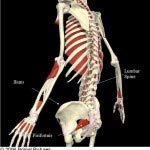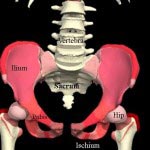Golfers' Low Back Pain - The Core Issue
Lower Back Anatomy
Anatomy, how the body is build, is a key to understanding the role of the low back in the golf swing. In this segment we are going to study the anatomy of the lower back and pelvis. There are many important structures in this area. There are vertebrae; discs; pelvic bones; hip joints; a multitude of muscles, ligaments, and tendons; nerves; and more.
Ischium
When we look at the boney structures of the lower back we find a stack of bones called vertebrae, which are separated by intervertebral discs. In our next installment we will talk about the discs in detail. For now, suffice it to say that the discs add height to the spinal column and act as cushions between the vertebrae. There are several important parts to a vertebra. The vertebral body is the weight-bearing structure in the spine. The spinous process is the point of bone you can feel in the middle of your back. The pedicle connects the posterior parts of the vertebra to elements of the vertebral body. The transverse process is a site for muscle attachment and the facet joints are the small joints off of the lamina that control motion of the spine.

The pelvis is a ring of bones at the bottom of the spine. It has two sides and each side is comprised of three fused bones: the ilium, the ischium, and the pubis. The sacrum, a combination of five fused vertebrae that sits between the left and right ilia and under the last lumbar vertebra is the base of the torso. It functions as the bucket that supports the abdominal contents and transmits forces from the lower extremities to the torso and vice versa. The hip sockets, or acetabula, are located on the outside of the ilia and have a slight downward and forward orientation.

Transverse Processes
Muscles that course from the thighs to the pelvis include the quadriceps (front of the thigh); hamstrings (back of the thigh); hip flexors (on the front of the hip); glutes, or hip extensors; hip rotators; and stabilizers. Muscles that course from the pelvis to the torso include the abdominals in the front, the erector spinae (in the back), and the quadratus lumborum (in the lateral lower back). These muscle groups create pelvic stability and hip mobility in life and in the golf swing.
Muscles and ligaments attach to all the boney prominences of the spine. These muscles course from one vertebra to the one above or below. Some connect from transverse process to transverse process (these are generally side benders of the spine). Some connect from spinous process to transverse process (these are rotators of the spine). Some connect from lamina to lamina (these are extenders of the spine). Different combinations of muscle contractions create the different motions of the spine. These muscles are very small. If you look at the web-space between your thumb and index finger, you will see a muscle that is similar in size to these small spinal muscles.

The hip internal rotators course from the front of the pelvis to the front of the hip. These small but powerful muscles are responsible for creating hip internal rotation in the golf swing. They are commonly very weak in golfers. The hip external rotators generally course from the buttock area to the back of the femur. These muscles are generally very tight in golfers. One external rotator, the gluteus medius, is also a lateral stabilizer. It is generally very weak in golfers, and as a result, golfers exhibit lateral stability problems in their swing.

While this all sounds very complicated, it is really quite simple. There are pairs of muscles on opposite sides of a joint or bone. These muscles act in opposition to one another to create mobility and or stability of the area where the muscle resides. The key to a good golf swing and a pain-free lower back is to make sure the pairs of muscles are working in sync with one another, in the correct sequence, and balanced in their tension and strength. This is the realm of golf fitness and preventing golfing injuries.
If you try these exercises and you find them to be too challenging or uncomfortable, do not continue, until you have consulted with your physician. All exercises for golf should be customized to your needs after a proper evaluation.
Come In and See Us
Want to take your golf to the next level? Our FitGolf® Trainers are experts at working one-on-one with you to tailor a training program to meet the specific needs of your body and help you achieve the results you are hoping to see in your golf.
Want More Resources?
Looking for more exercise resources, blog posts or monthly golf-specific exercise content sent straight to your inbox?
